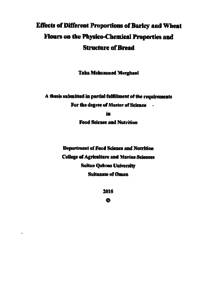وثيقة
Effects of different proportions of barley and wheat flours on the physico-chemical properties and structure of bread
الناشر
Sultan Qaboos University
ميلادي
2015
اللغة
الأنجليزية
الملخص الإنجليزي
Researches on bread making from combined barley and wheat flours are limited. Therefore, the main objective of this research was to study the effects of different proportions of barley and wheat flours on the physico-chemical properties and structure of bread. The bread was produced by mixing hard wheat flour (Canadian western Red Spring) with barley flour using different percentage of wheat and barley flour i.e., (100:0), (90:10), (85: 15) and (75: 25), respectively. The flour samples of wheat and barley were obtained using Buhler laboratory mill. The chemical compositions of the four formulated mixes were measured. The results showed variation in chemicals composition due to addition of barley, overall reduction in protein and gluten content and increasing in ash content and enzyme activity by adding of barley flour. The rheological characteristics of the four formulated dough mixes were studied by: Frarinograph, Extinsograph and Alveuograph, which showed significant decreasing of water absorption (p<0.05) and stability (p<0.01) by increasing barley flour, while no changes in extensibility and maximum heights. The structural and physical properties and visualized image analysis of breads were studied. Results showed; significantly decreasing (p<0.1) in crumb, apparent density with the increase of barley flour. Also, the porosity (i.e., fraction to total volume) increased with the increase of barley (p<0.1). There is no significant effect of barley (i.e. up to 25% of barley) on the final bread volume (p<0.05). Overall shape and pore structure at 10 % level of barley were similar to the pure wheat flour bread, while 15% and 25 % of barley showed more non-uniform and larger pores.
المجموعة
URL المصدر
الملخص العربي
إن الدراسات حول الخبز المصنوع من خلط طحين الشعير و القمح معا قليله. ولذلك فإن هذا البحث يسلط الضؤ على دراسة انتاج خبز بواسطة خلط طحين القمح الصلب ( القمح الكندي الأحمر الربيعي) مع طحين الشعير (صنف فاسيوم) بنسب مختلفة . تتفاوت نسبة طحين القمح الى طحين الشعير على النحو التالي ( 100: 0) ، (90:10) ، ( 85 : 15 ) ، ( 75 : 25 ) حيث تمثل النسبة الأعلى القمح دائما. تم طحن عينتي القمح والشعير بواسطة طاحونة مخبرية من نوع. تم بعد ذلك اجراء التحاليل والحصول على نتائج التحليل الكيميائي لخلطات القمح والشعير المختلفة. اتت النتائج في مجملها تبين التفاوت الناتج من اضافة الشعير .حيث تبين انخفاض مستوي البروتين و مستوي الجولتين ، مع زيادة في نشاط الانزيمات وارتفاع محتوي المعادن في شكل رماد. تم ايضا اختبار خصائص العجينة المتكونة من الخلطات المذكورة سابقا للقمح والشعير ، وذلك بواسط أجهزة الفارينوجراف والاكستنسوجراف والالفيو جراف .اوضحت النتائج انخفاض في درجة تشرب العجينة بالماء (0.5>P) ودرجة ثبات العجينة ( 0.1>P) وذلك بعد اضافة الشعير بنسب مختلفة، في حين أن درجة مطاطية العجينة ودرجة مقاومة العجينة للمط وجد انها ثابتة لاتتغير باضافة الشعير. تم استخدام طريقة العجن المباشر في صنع الخبز. تم بعد ذلك اختبار صفات الخبز الفيزيائية وفحص تركيب لب الخبز والقشر الخارجية وتدقيق وملاحظة صور شرائح الخبز المختلفة لمعرفة تأثير اضافة الشعير. أوضحت النتائج انخفاض ملحوظ في كثافة لب الخبز ( 0.1>P) بزيادة نسبة طحين الشعير. تبين ايضا زيادة مسامية لب الخبز (0.1>P) . لوحظ كذلك عدم التغيير الملموس ( 0.05>P) في الحجم الكلي للخبز عند اضافة طحين الشعير حتى نسبة تصل الي 25 % . الشكل العام والتركيب الداخلي للخبز لم يتغير في حالة اضافة 10% من طحين الشعير ، في حين أن اضافة الشعير بنسب تصل الى 15 و25% ادت الى وجود مسام كبير وغير متجانسة الشكل في تركيب لب الخبز.
قالب العنصر
الرسائل والأطروحات الجامعية


